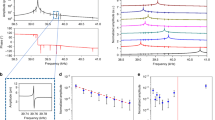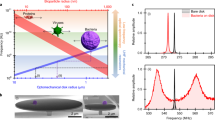Abstract
Mass sensing with nanoelectromechanical systems has advanced significantly during the last decade. With nanoelectromechanical systems sensors it is now possible to carry out ultrasensitive detection of gaseous analytes, to achieve atomic-scale mass resolution and to perform mass spectrometry on single proteins. Here, we demonstrate that the spatial distribution of mass within an individual analyte can be imaged—in real time and at the molecular scale—when it adsorbs onto a nanomechanical resonator. Each single-molecule adsorption event induces discrete, time-correlated perturbations to all modal frequencies of the device. We show that by continuously monitoring a multiplicity of vibrational modes, the spatial moments of mass distribution can be deduced for individual analytes, one-by-one, as they adsorb. We validate this method for inertial imaging, using both experimental measurements of multimode frequency shifts and numerical simulations, to analyse the inertial mass, position of adsorption and the size and shape of individual analytes. Unlike conventional imaging, the minimum analyte size detectable through nanomechanical inertial imaging is not limited by wavelength-dependent diffraction phenomena. Instead, frequency fluctuation processes determine the ultimate attainable resolution. Advanced nanoelectromechanical devices appear capable of resolving molecular-scale analytes.
This is a preview of subscription content, access via your institution
Access options
Subscribe to this journal
Receive 12 print issues and online access
$259.00 per year
only $21.58 per issue
Buy this article
- Purchase on Springer Link
- Instant access to full article PDF
Prices may be subject to local taxes which are calculated during checkout




Similar content being viewed by others
References
Ekinci, K. L., Huang, X. M. H. & Roukes, M. L. Ultrasensitive nanoelectromechanical mass detection. Appl. Phys. Lett. 84, 4469–4471 (2004).
Ilic, B. et al. Attogram detection using nanoelectromechanical oscillators. J. Appl. Phys. 95, 3694–3703 (2004).
Yang, Y. T., Callegari, C., Feng, X. L., Ekinci, K. L. & Roukes, M. L. Zeptogram-scale nanomechanical mass sensing. Nano Lett. 6, 583–586 (2006).
Li, M., Tang, H. X. & Roukes, M. L. Ultra-sensitive NEMS-based cantilevers for sensing, scanned probe and very high-frequency applications. Nature Nanotech. 2, 114–120 (2007).
Gil-Santos, E. et al. Nanomechanical mass sensing and stiffness spectrometry based on two-dimensional vibrations of resonant nanowires. Nature Nanotech. 5, 641–645 (2010).
Chen, C. Y. et al. Performance of monolayer graphene nanomechanical resonators with electrical readout. Nature Nanotech. 4, 861–867 (2009).
Hanay, M. S. et al. Single-protein nanomechanical mass spectrometry in real time. Nature Nanotech. 7, 602–608 (2012).
Naik, A. K., Hanay, M. S., Hiebert, W. K., Feng, X. L. & Roukes, M. L. Towards single-molecule nanomechanical mass spectrometry. Nature Nanotech. 4, 445–450 (2009).
Schmid, S., Kurek, M., Adolphsen, J. Q. & Boisen, A. Real-time single airborne nanoparticle detection with nanomechanical resonant filter-fiber. Sci. Rep. 3, 1288 (2013).
Gupta, A., Akin, D. & Bashir, R. Single virus particle mass detection using microresonators with nanoscale thickness. Appl. Phys. Lett. 84, 1976–1978 (2004).
Burg, T. P. et al. Weighing of biomolecules, single cells and single nanoparticles in fluid. Nature 446, 1066–1069 (2007).
Jensen, K., Kim, K. & Zettl, A. An atomic-resolution nanomechanical mass sensor. Nature Nanotech. 3, 533–537 (2008).
Chiu, H. Y., Hung, P., Postma, H. W. & Bockrath, M. Atomic-scale mass sensing using carbon nanotube resonators. Nano Lett. 8, 4342–4346 (2008).
Lassagne, B., Garcia-Sanchez, D., Aguasca, A. & Bachtold, A. Ultrasensitive mass sensing with a nanotube electromechanical resonator. Nano Lett. 8, 3735–3738 (2008).
Chaste, J. et al. A nanomechanical mass sensor with yoctogram resolution. Nature Nanotech. 7, 300–303 (2012).
Dohn, S., Sandberg, R., Svendsen, W. & Boisen, A. Enhanced functionality of cantilever based mass sensors using higher modes. Appl. Phys. Lett. 86, 233501 (2005).
Dohn, S., Svendsen, W., Boisen, A. & Hansen, O. Mass and position determination of attached particles on cantilever based mass sensors. Rev. Sci. Instrum. 78, 103303 (2007).
Dohn, S., Schmid, S., Amiot, F. & Boisen, A. Position and mass determination of multiple particles using cantilever based mass sensors. Appl. Phys. Lett. 97, 044103 (2010).
Tamayo, J., Ramos, D., Mertens, J. & Calleja, M. Effect of the adsorbate stiffness on the resonance response of microcantilever sensors. Appl. Phys. Lett. 89, 224104 (2006).
Ramos, D. et al. Arrays of dual nanomechanical resonators for selective biological detection. Anal. Chem. 81, 2274–2279 (2009).
Tamayo, J., Kosaka, P. M., Ruz, J. J., San Paulo, Á. & Calleja, M. Biosensors based on nanomechanical systems. Chem. Soc. Rev. 42, 1287–1311 (2013).
Landau, L. D., Lifshits, E. M., Kosevich, A. D. M. & Pitaevskii, L. P. in Course of Theoretical Physics 3rd English edn, Vol. VIII, 187 (Pergamon, 1986).
Hausdorff, F. Moment problems for an infinite interval. Math. Z. 16, 220–248 (1923).
Athanassoulis, G. A. & Gavriliadis, P. N. The truncated Hausdorff moment problem solved by using kernel density functions. Probabilist. Eng. Mech. 17, 273–291 (2002).
Ginger, D. S., Zhang, H. & Mirkin, C. A. The evolution of dip-pen nanolithography. Angew. Chem. Int. Ed. 43, 30–45 (2004).
Ekinci, K. L., Yang, Y. T. & Roukes, M. L. Ultimate limits to inertial mass sensing based upon nanoelectromechanical systems. J. Appl. Phys. 95, 2682–2689 (2004).
Acknowledgements
The authors acknowledge support from an NIH Director's Pioneer award (to M.L.R.), a Caltech Kavli Nanoscience Institute Distinguished Visiting Professorship (to J.E.S.), the Fondation pour la Recherche et l'EnseignementSuperieur, Paris (FRES; to M.L.R.), and the Australian Research Council grants scheme (P.M. and J.E.S.).
Author information
Authors and Affiliations
Contributions
M.L.R. and J.E.S. supervised the project. J.E.S. provided the principal mathematical idea for mass measurement using mode superposition that was extended to imaging by M.L.R. The resulting theory was further developed by M.S.H., S.I.K., J.E.S., and M.L.R. Droplet measurements were conceived by J.E.S., performed by C.D.O., and supervised by P.M. and J.E.S. The paper was written by M.S.H., S.I.K., C.D.O., J.E.S., and M.L.R. The FE simulations were executed by M.S.H. and S.I.K. All authors analysed the data and contributed to the writing of the paper.
Corresponding authors
Ethics declarations
Competing interests
The authors declare no competing financial interests.
Supplementary information
Supplementary information
Supplementary information (PDF 2259 kb)
Rights and permissions
About this article
Cite this article
Hanay, M., Kelber, S., O'Connell, C. et al. Inertial imaging with nanomechanical systems. Nature Nanotech 10, 339–344 (2015). https://doi.org/10.1038/nnano.2015.32
Received:
Accepted:
Published:
Issue Date:
DOI: https://doi.org/10.1038/nnano.2015.32
This article is cited by
-
Strong unique continuation and global regularity estimates for nanoplates
Annali di Matematica Pura ed Applicata (1923 -) (2024)
-
Mass sensing based on nonlinear intermodal coupling via 2:1 internal resonance of electrostatically actuated clamped–clamped microbeams
International Journal of Dynamics and Control (2023)
-
Sliding nanomechanical resonators
Nature Communications (2022)
-
Hierarchical tensile structures with ultralow mechanical dissipation
Nature Communications (2022)
-
Inertial and viscous flywheel sensing of nanoparticles
Nature Communications (2021)



